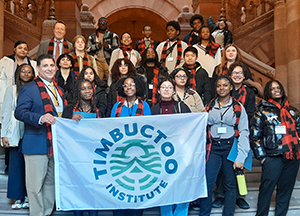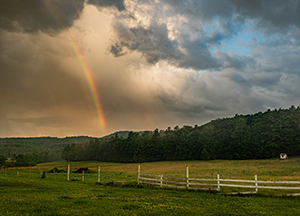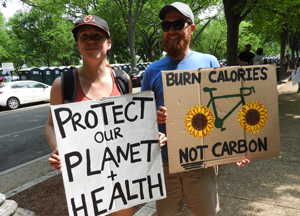
Conservation Organizations Urge Park Agency to Drop Motor Vehicle Plan
For immediate release, Monday, February 17, 2025
RAY BROOK, N.Y. -- Adirondack conservation organizations today said they were pleased that the Adirondack Park Agency (APA) was pausing on a controversial amendment to the Adirondack Park State Land Master Plan that would create an administrative loophole and open remote wilderness areas to motorized vehicles.
The organizations called on the APA to drop that portion of its proposal and instead allow the Dept. of Environmental Conservation (DEC) to lead on creating a statewide plan that excludes motor-free official Wilderness Areas.
The amendment is part of a package of recently proposed changes to the master plan, which governs public land management in the Adirondack Park. The proposed amendment would redefine "motor vehicle" to exclude motor vehicles, including cars, trucks and all-terrain vehicles if they are used by people with mobility disabilities.
The proposed change would mark a drastic weakening of the master plan, which has since its adoption in 1972 prohibited all public motor vehicle use on Forest Preserve lands classified as Wilderness Areas. It is opposed by the Adirondack Council, Adirondack Mountain Club, Adirondack Wild/Friends of the Forest Preserve, Adirondack Wilderness Advocates and Protect the Adirondacks! The organizations believe there is a better way to promote access for persons with disabilities, while at the same time protecting the few Wilderness Areas in the Adirondack Park from motorized intrusions.
Proposed Change Opens the Door for Motor Vehicles in Wilderness
Currently, powered wheelchairs are already allowed on all portions of the Adirondack Forest Preserve. Wheelchairs may go anywhere that feet are allowed to go.
The APA’s proposed amendment would address outdoor-only mobility devices, referred to as “other power-driven mobility devices” (OPDMDs). Motor Vehicle access is currently allowed for persons with disabilities in some “forever wild” Forest Preserve land classifications with a special DEC-issued permit under its CP-3 program. The program does not allow such vehicles in Wilderness, Primitive, and Canoe Areas. OPDMDs include golf carts, e-bikes, ATVs, UTVs, and trucks. Under the APA’s proposed amendment, these devices would be exempt from the master plan’s current definition of “motor vehicle,” thus lifting the ban on their use in Wilderness, Primitive, and Canoe Areas.
The organizations oppose the proposed amendment because it directly contravenes the master plan’s definition of Wilderness Areas and will permanently alter the Forest Preserve landscape and its ecologies. The APA has previously classified all of the potentially affected lands as being too sensitive for motorized recreation.
The Adirondack Park is a globally significant resource, representing one of the largest and most intact temperate forests left in the world. With wilderness areas making up only 3.3 percent of New York’s land, these protections are essential to preserving not only the ecological health of the region but also its cultural and recreational value, the organizations said.
The Americans with Disabilities Act allows for a balanced approach, recognizing the unique and sensitive qualities of Wilderness Areas. It exempts federally designated Wilderness Areas and allows states the flexibility to protect state-designed Wilderness Areas while expanding access elsewhere.
Call for Withdrawal of OPDMD Amendment and Creation of a Statewide Policy
The organizations call on APA to withdraw the OPDMD amendment to the definition of “motor vehicle” and instead focus on collaborative solutions that both improve access and uphold the agency’s conservation mandate. The organizations also urged the DEC to continue to lead in developing a statewide OPDMD policy.
The policy should reflect the input of a broader range of stakeholders including the accessibility community, be tailored to the unique needs of New York’s diverse landscapes and the constitutional and statutory protections governing the State’s Wilderness Areas, the organizations said. It should consider the practicalities of funding, implementation, and enforcement of such a policy.
Ultimately, a statewide policy would better ensure that accessibility measures are implemented with care, aligning with Wilderness protection principles and landscape contexts – rather than APA’s current approach. A statewide policy would also reduce barriers to those seeking accessible opportunities.
Motor Vehicles Jeopardize the Essence and Ecology of Wilderness
Federal guidelines allow states to develop OPDMD policies, including limitations on where these devices can or cannot go, their weight, noise and size. In addition, federally designated Wilderness Areas – upon which the definition of Wilderness in the master plan is based – do not allow OPDMDs.
This is because motor vehicles are inconsistent with Wilderness attributes, have negative impacts on wildlife, forest ecology and water quality. Currently, approximately 1.5 million acres of Wild Forest lands are open to motorized use, providing significant opportunities for persons using OPDMDs to access remote and wild parts of the Adirondack Forest Preserve.
Organizational Leaders Explain Why a Small Change Could Lead to Big Problems
“We believe that with thoughtful policy-making and inclusive dialogue, we can find a solution that both improves access and protects the integrity of these irreplaceable Wilderness lands,” said Raul J. Aguirre, Executive Director of the Adirondack Council. “With the proposed OPDMD amendment, the Agency is failing its core mandate when it comes to Wilderness protection and resource management. The DEC should lead in crafting a comprehensive, statewide policy that allows for a tailored approach to accessibility that respect the ecology and character of Wilderness Areas.”
“The Adirondack Park’s agencies should never allow ATVs and trucks labeled as mobility devices to invade rare Wilderness areas, said Adirondack Wild’s David Gibson. “The APA should keep the Motor Vehicle definition intact, continue to prohibit all motor vehicles in Wilderness, and push the DEC to draft predictive, ADA-compliant policy for the use of mobility devices on public lands statewide. DEC should also support services trained to assist persons with disabilities to experience Adirondack Wildernesses without use of motors. APA should keep Wilderness areas wild for the benefit of us all, and for the benefit of wildlife which cannot speak for themselves.”
“Wilderness is rare and precious and easily lost,” said Claudia Braymer, Executive Director of Protect the Adirondacks! “The Adirondack Park State Land Master Plan already directs APA to prioritize natural resource protection and APA should not adopt an amendment that eviscerates the core of wilderness protections.”
“No one wants to exclude people with mobility impairments from any part of the Adirondack Park. The Forest Preserve is for all, including the experience of a motor-free Wilderness. We are encouraged that DEC is pursuing an accessibility policy which will create clarity for land managers and recreators of all abilities. We urge the APA to revise its proposed amendment,” said ADK’s Julia Goren, Interim Executive Director.
“Adirondack Wilderness Advocates contends that the right of equitable access to public places and facilities for those with disabilities is fundamental,” said Board Chair Pete Nelson. “We contend that the right of Wilderness to be protected as defined in Federal law and in New York State law is also fundamental. These rights can be balanced in a reasonable way: our democracy has balanced differing interests and rights since its inception. There are a variety of ways to assist and accommodate people with mobility limitations who want to experience Wilderness; we don’t need motor vehicles to do it. The ADA already establishes this balance: the law allows access to Federal Wilderness by people in wheelchairs, but not OPDMDs. We should have the same balance in New York.”
It is unclear whether the APA will bring the proposal back to its board for preliminary approval at its March monthly meeting. Amendments to the State Land Master Plan require approval by the Governor.
FOR MORE INFORMATION
John F. Sheehan, Adirondack Council, 518-441-1340
Claudia Braymer, Protect the Adirondacks! Cell (703) 937-7163
David Gibson, Adirondack Wild: Friends of the Forest Preserve, 518-469-4081
Julia Goren, Adirondack Mountain Club, 518-523-3480 X 116
Pete Nelson, Chair, Adirondack Wilderness Advocates, 608-957-3142




